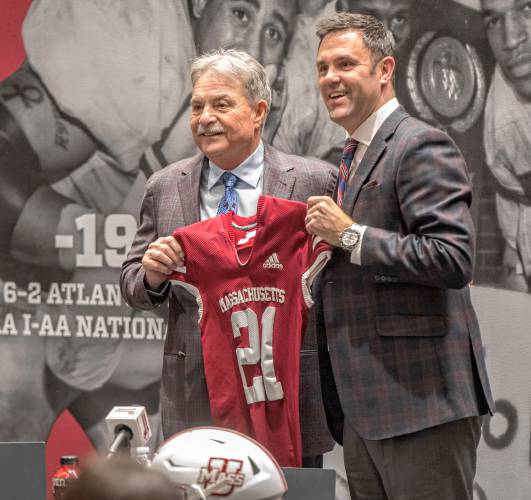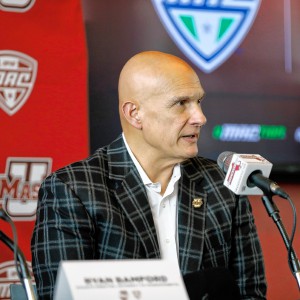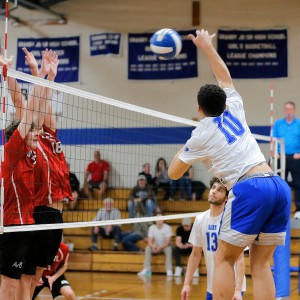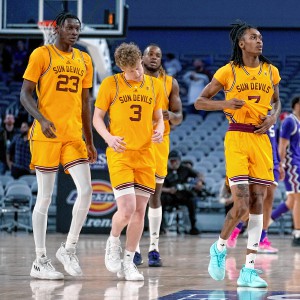With Delaware set to join Conference USA, UMass once again in the conference alignment discussion

UMass football coach Don Brown, left, and UMass AD Ryan Bamford pose during a press conference at Brown’s introduction in the Martin Jacobson Football Performance Center on Dec. 1, 2021. STAFF FILE PHOTO
|
Published: 11-27-2023 5:06 PM
Modified: 11-28-2023 10:11 AM |
Following Saturday’s 31-18 loss to Connecticut, the UMass football team’s 2023 season officially came to its conclusion. It’s a big offseason for the Minutemen, and work has begun immediately in hopes of continuing to build a program that finished 3-9 this fall — and is 24-102 since 2012.
The future of the program, while largely important via work done on the field, is likely to shift this offseason at the institutional level. The dominoes of conference realignment are falling around UMass yet again, and this time, the school needs to join the fray.
Perhaps the powder keg moment happened on Monday, when multiple media outlets reported that the University of Delaware will join Conference USA in all sports beginning in 2025. The driving force in the move? Football. The Blue Hens are a perennial power in the FCS, and will play at No. 2 Montana in the second round of the FCS playoffs this weekend. A move to FBS will elevate the entire Delaware athletic department, and it’ll happen with the support of a conference. The rest of the athletic department will leave the Coastal Athletic Association (CAA) to join Conference USA.
If this move seems familiar, it’s because UMass made a similar FBS leap in 2012, leaving the CAA (then the Colonial Athletic Association) behind for a move up. But unlike Delaware, the Minutemen joined the Mid-American Conference (MAC) as a football-only institution, staying in the Atlantic-10 Conference for all other sports. That move ultimately didn’t work, and the school left the conference in 2015 to become a football independent after refusing to join the MAC in all sports.
Which leads the school to its current predicament.
Life as an FBS independent not named Notre Dame hasn’t been kind. Army announced last month that it was leaving for greener pastures, and it will join the American Athletic Conference (AAC) as a football-only member beginning in 2024.
“In today’s evolving collegiate athletics landscape, it is great to partner with established, respected programs to secure the future success of Army football,” Army AD Mike Buddie said of the move. “New NCAA rules, the evolution and growth of the College Football Playoff, the transfer portal, and name, image and likeness have all impacted our competitive landscape, so having a clear path to a Conference Championship, while continuing to fight for the Commander-in-Chief’s Trophy, will help us attract, retain and showcase our exceptional coaches and cadets.”
Army’s move to the AAC leaves UMass, Notre Dame and UConn as the lone independents at the FBS level.
Article continues after...
Yesterday's Most Read Articles
 More than 130 arrested at pro-Palestinian protest at UMass
More than 130 arrested at pro-Palestinian protest at UMass
 Public gets a look at progress on Northampton Resilience Hub
Public gets a look at progress on Northampton Resilience Hub
 Northampton bans auto dealerships near downtown; zone change won’t affect Volvo operation on King Street
Northampton bans auto dealerships near downtown; zone change won’t affect Volvo operation on King Street
 UMass basketball: Bryant forward Daniel Rivera to be Minutemen’s first transfer of the offseason
UMass basketball: Bryant forward Daniel Rivera to be Minutemen’s first transfer of the offseason
 Town manager’s plan shorts Amherst Regional Schools’ budget
Town manager’s plan shorts Amherst Regional Schools’ budget
 Police respond to alcohol-fueled incidents in Amherst
Police respond to alcohol-fueled incidents in Amherst
When UMass announced its departure from the MAC in 2014, the presumption was that the school was looking for a new conference to join — one that was a better fit. But almost a decade later, and still with no conference affiliation, the football program unfortunately can’t afford to be as picky.
So what’s the move, and does the school really need to find a football conference? Great questions, I’m sure UMass athletic director Ryan Bamford has asked himself the same things for a while now.
Let’s start with an important distinction: no, dropping back to the FCS level is not a viable option for the football program. Sure, that would help with the conference issues, leaving the rest of the sports to compete in the A-10 while football slots back into (likely) the CAA. Get the old band back together. But no, it’s not a financially viable option, nor should the school consider it.
Can the school survive as a football independent? I mean, technically, they’re surviving right now, but without a conference they miss out on television rights, brand recognition/identity, revenue sharing, just to name a few. If you aren’t Notre Dame though, remaining independent is akin to driving down a pot-holed filled road with bad tires — it’s only a matter of time (something drivers in western Mass. are all too familiar with during the impending winter months).
Bamford knows all this. Behind the scenes for the past few years, he’s been positioning the university for a spot in a new conference. Say what you want about his tenure as AD (which began in 2015, after the school announced it was leaving the MAC), but there’s no doubt conference alignment has consumed the bulk of his billable hours over the past five years. The hold-up has almost certainly been the Atlantic 10 connection. The conference doesn’t sponsor football anymore (you knew that already), but has been a solid home for the school’s most historic program (men’s basketball) — though the A-10 was just a one-bid league last year. UMass was a founding member of the A-10, originally the Eastern Collegiate Basketball League, in 1976, along with Villanova, Duquesne, Penn State, West Virginia, George Washington, Pittsburgh, and Rutgers, before the Atlantic 10 became the Atlantic 10 in 1982. Certainly much has changed with the make-up since then, and almost all of those founding schools left for greener pastures.
It appears as though UMass will also have to leave in order to grow. With football the driving force behind almost all conference realignment (minus the Big East), there’s almost no chance UMass will be invited to join a new conference without taking all of its sports with it, or at least the sports sponsored by said conference. Hockey would remain in Hockey East, certainly, but it would not behoove a league to invite UMass without the entire Rolodex.
The Big Ten? A pipe dream. The AAC? Probably unlikely. Which leaves the aforementioned Conference USA as the most likely landing spot. The league is now at 11 schools for football (hello, 12-team league?) — FIU, Jacksonville St., Liberty, Louisiana Tech, Middle Tennessee, New Mexico St., Sam Houston St., UTEP, Western Kentucky, Kennesaw St. (future member, 2024) and Delaware (future member, 2025). Old friend the MAC could also be an option, so long as those relationships have been repaired from the first departure. Either way, a move must be coming for the long-term sustainability of the football program.
But is UMass a desirable addition to a conference? And what can the department offer a prospective partner? Those are the things Bamford has undoubtedly been selling behind the scenes, difficult discussions fit for the ninth-highest paid state employee in the Commonwealth. His next move is his most important one.
I would expect to hear some news from UMass regarding the future of its athletic department within the next few months, so stay tuned. The train is leaving the station, can the state’s flagship university book a ticket?

 Boys volleyball: Granby cruises to 3-0 sweep over Athol (PHOTOS)
Boys volleyball: Granby cruises to 3-0 sweep over Athol (PHOTOS) Baseball: Hampshire, South Hadley to ‘get a little taste of what it’s like to be a pro’ at Dunkin’ Park
Baseball: Hampshire, South Hadley to ‘get a little taste of what it’s like to be a pro’ at Dunkin’ Park Belchertown Twirlers capture first place at Northeast Regional Championships
Belchertown Twirlers capture first place at Northeast Regional Championships UMass basketball: Minutemen nab another transfer in Arizona State forward Akil Watson
UMass basketball: Minutemen nab another transfer in Arizona State forward Akil Watson
